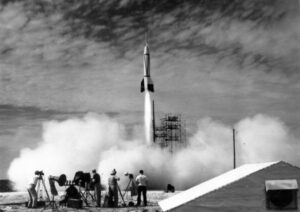24 July 1950 Cape Canaveral Air Force Station begins operations with the launch of a Bumper rocket.

As weapons development progressed after WWII, “ a site became necessary to develop tactics and techniques for guided missile operations, train personnel, test equipment used to operate the missiles and conduct functional and tactical tests of new guided missiles to determine their effectiveness.
A suitable facility would need to be relatively isolated from centers of population, provide a large expanse of unpopulated area over which missiles could fly and accommodate the installation of several downrange tracking stations. A base for military operational headquarters would also be required.
Although a missile range had been in operation at White Sands, New Mexico since the close of World War II, this range was only 135 miles long and was perilously close to populated areas. It proved to be too short for newer, more powerful missiles and too risky to support more advanced research and development tests.
The dangers of a missile range so close to populated areas would become painfully clear in May, 1947 when a V-2 rocket strayed to the south instead of heading north over the White Sands range. The missile flew directly over El Paso, Texas and eventually crashed into the Tepeyac Cemetery in Juarez, Mexico.”(1)
Three sites were considered, the Aleutian Islands, El Centro/Baja California and the Banana River Naval Station in FL. California was the original choice until “Mexican President Miguel Aleman refused to agree to allow missiles to fly over the Baja region”. The focus turned to Florida, and the British were very willing to allow missiles to fly over the Bahamas and lease land to the U.S. for tracking stations.
“On May 11, 1949 President Harry S. Truman signed legislation entitled Public Law 60 establishing the Joint Long Range Proving Ground at Cape Canaveral. The Banana River Naval Air Station, which had been transferred from the Navy to the Air Force on September 1, 1948 was renamed the Joint Long Range Proving Ground Base on June 10, 1949.”(1)
Though all the launch pads and buildings were not completed, “the Army scheduled launches of two modified German V-2 rockets for July, 1950. The rockets were called Bumper, and each employed a V-2 rocket as first stage and a Without Any Control (WAC)-Corporal rocket as second stage. The first rocket launch from Cape Canaveral, that of Bumper #8, occurred on July 24, 1950.”(1)
Sources: Wikipedia:Portal/Aviation; (1) Spaceline
